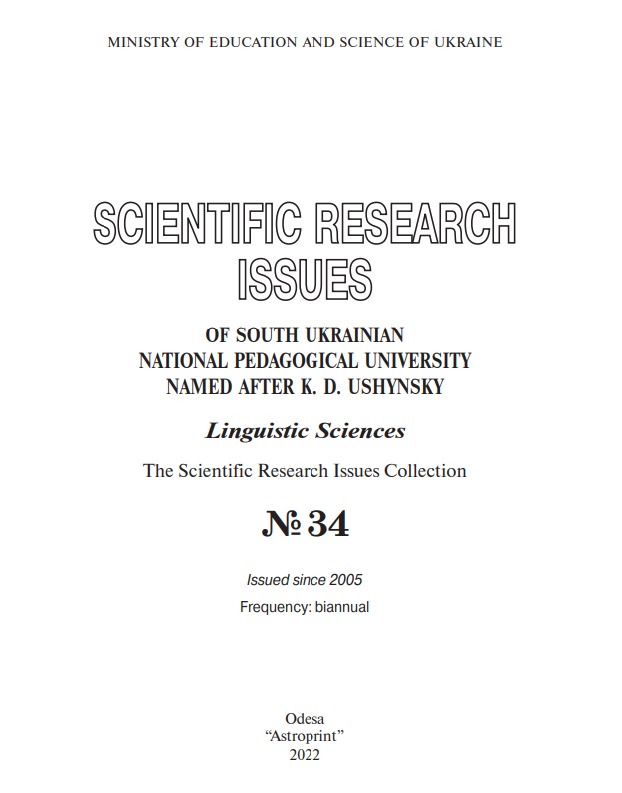Ph.D. in Philological Sciences, Assistant Professor, Assistant Professor
at the Department of Theoretical and Applied Linguistics
Zhytomyr Polytechnic State University,
Zhytomyr, Ukraine
103, Chudnivska str., Zhytomyr, 10005, Ukraine
e-mail: chernyshoxana@gmail.com
ORCID ID: 0000–0002–2010–200X
DOI:https://doi.org/10.24195/2616-5317-2022-34-9
Key words: discourse, Internet discourse, hypertextuality, interactivity, contextuality, procedurality
SUMMARY
The scientific article highlights the approaches to interpreting the notion of discourse. First, it considers the three most important approaches to defining this concept: formal, functional, and situational. Next, the article outlines constitutive, genre-stylistic, substantive, and formal-structural discourse categories. Finally, it analyses distinctive features of discourse, among which contextuality, personality, procedurality, theology, and the closed structure of discourse are distinguished, provided that textual information is available. Moreover, the article outlines the peculiarities of Internet discourse formation and highlights the approaches to its definition. Finally, it analyzes distinctive features of Internet discourse. It highlights its globality, the efficiency of information transfer, unlimited amount of information and possibility of its constant updating, accessibility, anonymity, visual decontextuality, interactivity, indirectness, emotionality, hypertextuality, hybridity, and equality, etc. The article proves that Internet discourse borrows the features of oral and written speech and acquires some distinctive features. In particular, Internet discourse is characterized by the lack of synchronous feedback, making it difficult to understand the perception of information by the recipient. In addition, this type of discourse is characterized by a relatively slow pace of Internet communication, complications or lack of communicative role change, lack of prosody and paralingual means, and the impossibility of live spontaneous speech as a reaction to what is heard. The article highlights the prospects for further research. It stresses the significance of studying the genre and stylistic features of Internet discourse and its structural and communicative-pragmatic features.
REFERENCES
Anisenko, O. Ju. (2004). Lingvistika i lingvisticheskoe obrazovanie v sovremennom mire. [Linguistics and linguistic education in the modern world]. Materialy mezhdunarodnoj konferencii, posvjashhennoj 100-letiju so dnja rozhdenija professora V. D. Arakina (g. Moskva 18–19 nojabrja 2004 g.) (pp. 125–127). M.: Prometej [in Russian].
Ahrenova, N. A. (2009). Internet-diskurs kak global’noe mezhkul’turnoe javlenie i ego jazykovoe oformlenie [Internet discourse as a global intercultural phenomenon and its linguistic design]. Extended abstract of Doctor’s thesis. M.. [in Russian].
Batsevych, F. (2005). Linhvistychna henolohiia: problemy i perspektyvy: Monohrafiia [Linguistic genealogy: problems and prospects: Monograph]. Lviv: PAIS, 264 s. [in Ukrainian].
Varlamova, E. V. (2006). Osobennosti germanskogo levoradikal’nogo Internet-diskursa [Features of the German radical left Internet discourse]. Candidate’s thesis. M. [in Russian].
Hudz, N. O. (2012). Internet-dyskurs yak nevidiemna skladova suchasnoi komunikatsii [Internet discourse as an integral part of modern communication]. Visnyk Zhytomyrskoho derzhavnoho universytetu. Filolohichni nauky. Vyp. 4 (70). S. 228–232. [in Ukrainian].
Dudoladova, O. V. (2008). Internet-dyskurs yak osoblyvyi typ dyskursu [Internet discourse as a special type of discourse]. Visnyk Kharkivskoho natsionalnoho universytetu im. V. N. Karazina. № 837. S. 74–78. [in Ukrainian].
Zvegincev, V. A. (1976). Predlozhenie i ego otnoshenie k jazyku i rechi [The sentence and its relation to language and speech]. M.: Izd-vo Mosk. un-ta. [in Russian].
Ivanov, L. Ju. Jazyk interneta: zametki lingvista [Internet language: notes of a linguist]. Retrieved from: http://www.twirpx.com/file/751186 [in Russian].
Karasik, V. I. (2004). Jazykovoj krug: lichnost’, koncepty, diskurs [Language circle: personality, concepts, discourse]. M.: Gnozis. 477 s.
Karpa, I. B. (2010). Funktsionalni ta prahmatychni kharakterystyky interaktyvnoi virtualnoi komunikatsii (na materiali informatsiino-dovidkovoho servisu Yahoo! Answers) [Functional and pragmatic characteristics of interactive virtual communication (based on the information and reference service Yahoo! Answers)]. Kherson. Extended abstract of candidate’s thesis. 20 s. [in Ukrainian].
Karpenko, M. Iu. (2016). Linhvistychni osoblyvosti Internet-dyskursu [Linguistic features of Internet discourse]. Mova. № 26. S. 5–11. [in Ukrainian].
Lukashenko, N. H. (2006). Ispanomovnyi Internet-dyskurs: komunikatyvno-prahmatychnyi ta linhvostylistychnyi aspekty (na materiali forumiv z problematyky rodynnykh stosunkiv) [Spanish-language Internet discourse: communicative-pragmatic and linguistic-stylistic aspects (based on forums on family relations)]. Extended abstract of candidate’s thesis. Kyiv. 22 s. [in Ukrainian].
Podol’skaja, (2006). E. A. Slovar’ obshhestvennyh nauk: filosofija, religiovedenie, kul’turologija, politologija, sociologija, jetika, jestetika [Dictionary of Social Sciences: Philosophy, Religious Studies, Cultural Studies, Political Science, Sociology, Ethics, Aesthetics]. Rostov n/D.: Feniks. 475 s. [in Russian].
Potapova, R. K. (2001). Rech’: kommunikacija, informacija, kibernetika [Speech: communication, information, cybernetics]. M.: URSS. 568 s. [in Russian].
Raspopina, E. Ju. (2012). Strategicheskij aspekt informacionnogo zhanra internet-diskursa [Strategic aspect of the information genre of Internet discourse]. Extended abstract of candidate’s thesis. Irkutsk. 21 s. [in Russian].
Rizhkov, M. S. Precedentnye personazhi sinhronnogo internet-diskursa [Precedent Characters of Synchronous Internet Discourse]. Retrieved from: http://lse2010.narod.ru/lcseissue8/ [in Russian].
Romanov, O. V. Ontologicheskie i gnoseologicheskie problemy filosofii Interneta (Genezis i sintez fundamental’nyh idej) [Ontological and epistemological problems of the philosophy of the Internet (Genesis and synthesis of fundamental ideas)]. Retrieved from: http://www. dslib.net/ontologia/ontologicheskie-i-gnoseologicheskie-problemy-filosofii-interneta.html [in Russian].
Selivanova, O. O. (2011). Osnovy teorii movnoi komunikatsii [Fundamentals of the theory of language communication]. Cherkasy: Vyd-vo Chabanenko Yu.A.. 350 s. [in Ukrainian].
Selivanova, O. O. (2011). Linhvistychna entsyklopediia [Linguistic encyclopedia]. Poltava: Dovkillia-K. 844 s. [in Ukrainian].
Stepanov, Ju.S. Al’ternativnyj mir, diskurs, fakt i princip prichinnosti [Alternative world, discourse, fact and principle of causality]. Retrieved from: http://abuss.narod.ru/Biblio/stepanov.htm [in Russian].
Shkvorchenko, N. (2019). Internet-dyskurs yak linhvistychna katehoriia [Internet discourse as a linguistic category]. Aktualni pytannia humanitarnykh nauk. Vyp. 23. Tom 3. S. 62– 68. [in Ukrainian].
Brown, G. (1983). Discourse Analysis. Cambridge: Cambridge University Press. 283 p. [in English].
Crystal, D. (2004). Language and the Internet. Cambridge: Cambridge University Press. 272 p. [in English].
Harris, Z. (1952). Discourse Analysis. Language. Vol. 28, № 17. P. 1–30. [in English].

